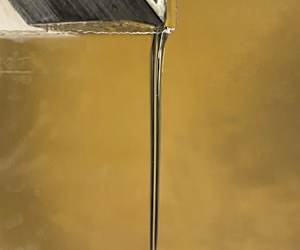No CrossRef data available.
Article contents
On the shapes of liquid curtains flowing from a non-vertical slot
Published online by Cambridge University Press: 26 October 2023
Abstract

A theoretical and experimental investigation of two-dimensional (2-D) liquid curtains (gravitationally thinning liquid sheets) is provided under conditions where the curtain issues from a thin slot whose centreline is inclined with respect to the vertical. This analysis is motivated in part by recent works where it has been proposed that oblique liquid curtains (those exiting a non-vertical slot) may bend upwards against gravity when the relevant Weber number at the slot is less than unity ( $We <1$). By contrast, Weinstein et al. (J. Fluid Mech., vol. 876, 2019, R3) have proposed that such
$We <1$). By contrast, Weinstein et al. (J. Fluid Mech., vol. 876, 2019, R3) have proposed that such  $We<1$ curtains must be vertical and downward falling regardless of the inclination of the slot. Under low-Reynolds-number (
$We<1$ curtains must be vertical and downward falling regardless of the inclination of the slot. Under low-Reynolds-number ( $Re$) conditions typical of liquid film coating operations, our experiments show that the curtain shape follows the classic ballistic (parabolic) trajectory in the supercritical regime (
$Re$) conditions typical of liquid film coating operations, our experiments show that the curtain shape follows the classic ballistic (parabolic) trajectory in the supercritical regime ( $We>1$). In subcritical conditions (
$We>1$). In subcritical conditions ( $We<1$), experiments show that the downward-falling curtain is vertical except in a relatively small region near the slot, where the combined effects of viscosity and surface tension induce the so-called teapot effect. These experimental results are confirmed by 2-D numerical simulations, which predict the curtain behaviour ranging from highly viscous (
$We<1$), experiments show that the downward-falling curtain is vertical except in a relatively small region near the slot, where the combined effects of viscosity and surface tension induce the so-called teapot effect. These experimental results are confirmed by 2-D numerical simulations, which predict the curtain behaviour ranging from highly viscous ( $Re = O(1)$) to nearly inviscid conditions. The one-dimensional (1-D) inviscid model of Weinstein et al. is recast in a different form to facilitate comparisons with the 2-D model, and 1-D and 2-D results agree favourably for supercritical and subcritical conditions. Despite the large parameter range explored, we have found no evidence that upward-bending curtains exist in an oblique configuration.
$Re = O(1)$) to nearly inviscid conditions. The one-dimensional (1-D) inviscid model of Weinstein et al. is recast in a different form to facilitate comparisons with the 2-D model, and 1-D and 2-D results agree favourably for supercritical and subcritical conditions. Despite the large parameter range explored, we have found no evidence that upward-bending curtains exist in an oblique configuration.
JFM classification
- Type
- JFM Papers
- Information
- Copyright
- © The Author(s), 2023. Published by Cambridge University Press





